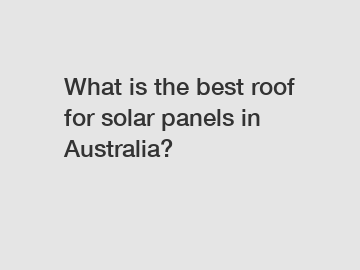What is the best roof for solar panels in Australia?
Solar panels are becoming increasingly popular in Australia, with many homeowners looking to harness the power of the sun to generate electricity for their homes. One crucial consideration when installing solar panels is the type of roof they will be placed on. Not all roofs are created equal when it comes to supporting solar panels and maximizing their efficiency. In this article, we will explore the best roof types for solar panels in Australia.
**Roof Orientation and Tilt**.
One of the most critical factors in determining the best roof for solar panels is orientation and tilt. In Australia, the ideal orientation for solar panels is north-facing, as this allows them to capture the most sunlight throughout the day. A roof with a tilt of around 30 to 35 degrees is also optimal for solar panel efficiency. However, roofs facing east or west can also be suitable for solar panels, with a slight reduction in energy output compared to a north-facing roof.

**Roof Material**.
The material of the roof is another essential consideration when choosing the best roof for solar panels. Metal roofs, such as Colorbond or zincalume, are excellent choices for solar panel installations. These types of roofs are durable, long-lasting, and provide a stable surface for mounting solar panels. Tile roofs can also support solar panels, although installation may be more challenging and costly due to the fragility of the tiles.
**Roof Size and Shape**.
The size and shape of the roof will also impact the installation of solar panels. A larger roof area allows for more solar panels to be installed, maximizing energy production. Additionally, a simple roof shape, such as a gable or hip roof, is easier to work with when installing solar panels. Complex roof designs with multiple angles and levels may require custom solutions for mounting solar panels, which can increase installation costs.
**Roof Shading**.
Shading is another critical factor to consider when determining the best roof for solar panels. Trees, buildings, or other structures that cast shadows on the roof can reduce the amount of sunlight reaching the solar panels, decreasing their efficiency. It is essential to ensure that the chosen roof location for solar panels is unobstructed and receives ample sunlight throughout the day.
**Roof Age and Condition**.
The age and condition of the roof are essential considerations when installing solar panels. A newer roof in good condition is best suited for supporting solar panels, as it will provide a secure and stable foundation for installation. Older roofs may require repairs or reinforcement before solar panels can be safely installed. It is recommended to have a professional roof inspection done before installing solar panels to ensure the roof can support the additional weight and stress.
**Conclusion**.
In conclusion, the best roof for solar panels in Australia is one that is north-facing or has a favorable east or west orientation, has a suitable roof material such as metal or tile, is large with a simple shape, is unobstructed by shading, and is in good condition. By considering these factors when choosing a roof for solar panels, homeowners can ensure they maximize the energy production of their solar system. For more information on the best roof for solar panels or to schedule a solar panel installation, contact us today.
Contact us for a consultation and learn how you can make the most of solar energy in your home.
Contact us to discuss your requirements of solar panel skylight manufacturer, bipv solutions, integrated solar roof tiles. Our experienced sales team can help you identify the options that best suit your needs.

Comments